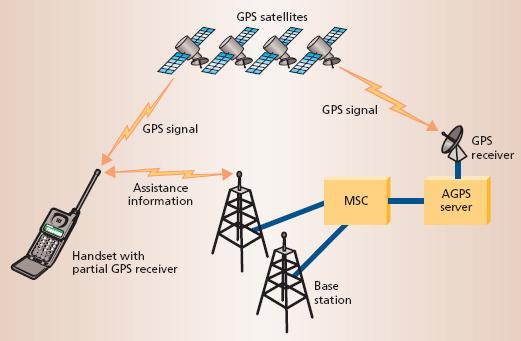Min Yin (Casey) Yap
Future Technology: Assisted GPS (A-GPS)
GPS
Without much doubt, most of us, if not all, are aware of what is the GPS (Global Positioning System) technology. Though we know about the advantages of GPS, it suffers from three significant limitations:
• The mobile unit must locate and receive signals from at least four satellites to be able to determine its location. This process of locating satellites, receiving the data and achieving a position fix may take several minutes. This delay is problematic to real-time applications, such as the location-based services.
• The mobile unit needs a clear view of the sky to successfully receive signals from the satellites. Under unfriendly conditions, such as in building, in urban ‘canyons’, accuracy of the position fix can be compromised.
• Finally, there remain questions of cost, size and power consumption when incorporating GPS receivers into trendy, miniature handsets.
Introducing Assisted-GPS (A-GPS)
Figure 1: Assisted-GPS concept
In regular GPS networks there are only GPS satellites and GPS receivers. A-GPS differs from regular GPS by adding another element, the AGPS Server. As Figure 1 shows, A-GPS consists of
• a wireless handset with a partial GPS receiver
• an AGPS server with a reference GPS receiver that can simultaneously “see” the same satellites as the handset
• a wireless network infrastructure consisting of base stations and a mobile switching center.
Assisted GPS describes a system where outside sources, such as AGPS Server in a network, help a GPS receiver perform the tasks required to make range measurements and position solutions. The server has the ability to access information from the reference network and also has computing power far beyond that of the GPS receiver. In this case, the AGPS server communicates with the GPS receiver on the mobile phone on a network. With assistance from the network, the receiver can operate more quickly and efficiently than it would unassisted, because a set of tasks that it would normally handle is shared with the AGPS server.
Advantages of A-GPS
• Shorter Delay The network can accurately predict the GPS signal the handset will receive and convey that information to the mobile, greatly reducing search space size and shortening the TTFF (Time to First Fix) from minutes to a second or less.
• Higher Accuracy A-GPS is accurate within 50 meters when users are indoors and 15 meters when they are outdoors, well within federal guidelines and an order of magnitude more sensitive than conventional GPS.
• Less-Complexity of Mobile Unit Because the network performs the location calculations, the handset only needs to contain a scaled-down GPS receiver. The low complexity has also minimal impact on the battery life of mobile unit.
Current Development
The A-GPS technology has already been widely deployed with considerable success by 3G UMTS network operators in the US, Japan and Korea. In the United States, the E911 regulations have been and remain a major catalyst for this deployment (E911 is a service that requires the network operators to provide the exact location of a cell phone that is used to dial 911). With millions of emergency calls being made each year from cell phones, A-GPS will greatly assist in saving lives and provide swift support to exactly the correct location. In Europe, the commercial potential of Location Based Services (LBS) is driving the technology. A few UMTS operators, such as 3 in the UK, are offering A-GPS location services from network launch.
Related News
Visitor to this year's CeBIT fair in Hannover demonstrates lack of mobile know-how, attempts theft of Siemens SX1 prototype fitted with positioning technology.
Siemens SX1 AGPS thief caught red-handed
References
1. Assisted GPS: A Low Infrastructure Approach
2. Geolocation and Assisted-GPS
3. Assisted GPS: using cellular telephone networks for GPS anywhere
